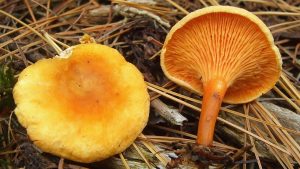#069: Amanita muscaria, Part 1: The Type Mushroom
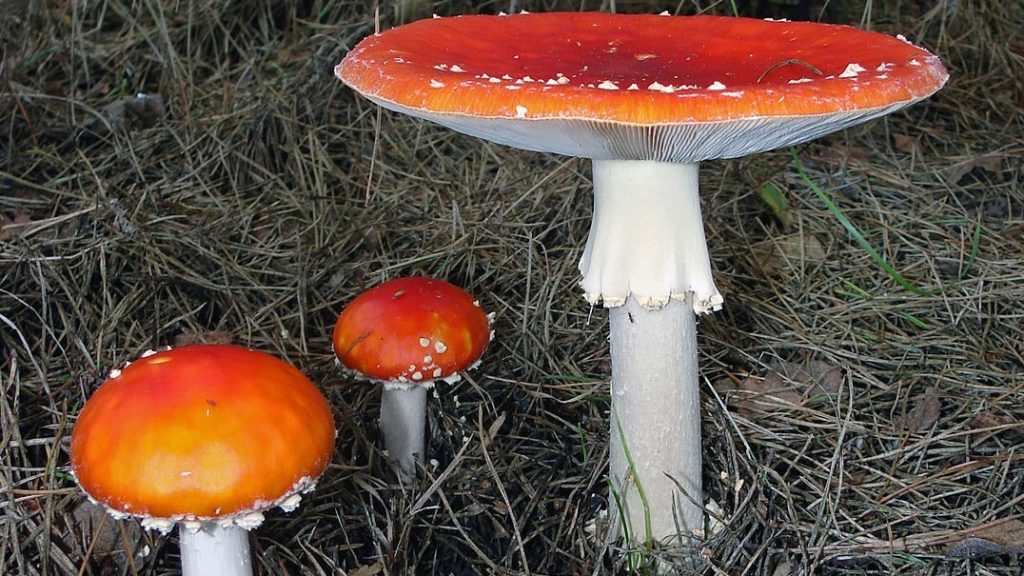
Amanita muscaria, can be identified by their warts, skirt-like ring, and concentric fuzzy zones on the base. By Chrumps [GFDL or CC BY-SA 3.0], via Wikimedia Commons (cropped).
Morphology
Amanita muscaria produces large, umbrella-shaped agaric mushrooms with a circular, brightly colored pileus and a central, white stipe. The pileus ranges in size from 5cm in the smallest specimens to 30cm or more in the largest individuals. Likewise, the stipe varies greatly in length; it can be as short as 5cm or as long as 20cm. At first the pileus is roughly spherical in shape, but it soon opens up to become convex. Older mushrooms may have a pileus that is mostly flat.1–3
Although artists usually depict the Fly Agaric with a red cap, the color of the pileus varies from red to orange to yellow to white. When fresh, the pileus is adorned with pale, cottony bumps known as warts. The warts are also variable in color: they may be white, off-white, or even yellowish. Warts are remnants of the universal veil, an external membrane that protects the developing mushroom. Immature Fly Agaric mushrooms still enclosed by the universal veil are white, egg-shaped, and known as “buttons.” As the mushroom matures, the expanding pileus breaks through the universal veil. There are a number of ways that the universal veil can fragment, but in the Fly Agaric it always breaks up into small, evenly spaced, bumpy warts. The warts can be easily brushed off of the cap, so they are sometimes not present on older specimens.1–4
Underneath the pileus, A. muscaria forms white gills that are close together. These plates of tissue are perpendicular to the cap surface and radiate out from the central pileus. The gills produce basidiospores (sexual spores) and are designed to greatly increase the surface area on which spores are produced. Like other Amanita species, the gills are free and give a white spore print.1,3,5
The white stipe, which holds the pileus and gills above the ground, is more or less equal in thickness but has a swollen base. Its texture is variable and can be smooth to shaggy. The most striking feature of the stipe is its skirt-like ring. A ring is formed when the partial veil – a membrane which protects the developing gills – separates from the edges of the pileus but remains attached to the stipe. In the Fly Agaric, the thick, white, circular membrane drapes down from its point of attachment near the top of the stipe much like a skirt would.1–3
The stipe usually ends in a swollen base. One of the most important identifying features of A. muscaria is found on top of the enlarged base. The base always has concentric rings of tissue around the top edges. These rings are the remains of the lower half of the universal veil (the top half resulted in warts on the pileus).1–3 You can quickly tell whether your mushroom is A. muscaria by checking for the presence of warts, a skirt-like ring, and concentric shaggy zones on top of the base. Although many other Amanita species have each of those characteristics, the Fly Agaric is the only one with all three.1
Ecology
Amanita muscaria is found on the ground in mixed forests throughout the northern hemisphere, where it forms mycorrhizal associations with both conifers and hardwoods. As a result of these associations, A. muscaria is often found fruiting in fairy rings around its host tree. Although the Fly Agaric can form mycorrhizas with a variety of tree species, its preferred hosts vary by geographical region. The mushrooms usually appear in the summer and fall, but may appear at other times in places with mild climates (such as California).1–3
Edibility
Some people collect and eat this mushroom for its mild hallucinogenic effects, but this is risky. Although A. muscaria does contain mind-altering compounds, it also contains gastrointestinal irritants. Because of the great variety within the species, it is impossible to say which of these affects will be stronger in a specific mushroom.4
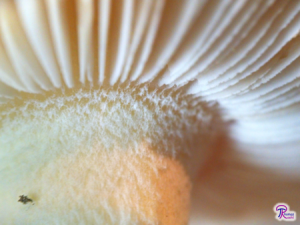
A. muscaria has free gills. This is easy to see in the photo above, where the gills are very far away from the stipe.
There are a number of methods which supposedly reduce the poisonous effects of the mushroom, but these are unproven and sometimes just plain gross.3,4 For these reasons and because other deadly Amanita species may be mistaken for the Fly Agaric, mycologists recommend against eating A. muscaria.
The psychoactive compounds in A. muscaria are ibotenic acid and muscimol (see FFF#097). Ibotenic acid activates NMDA receptors and muscimol activates GABA receptors. These two compounds result in hallucinations, “expanded perception,” perceiving objects as larger than they are, and fear inhibition. Other side effects of these compounds include a dry mouth and rapid heartbeat. Studies of ibotenic acid and muscimol in mice have shown that they inhibit learning in the amygdala, which blocks fear and suppresses the startle reflex. Depending on the relative abundance of these compounds, symptoms can range from mild intoxication to those of alcohol poisoning to hallucinations.4 It seems to me that drinking alcohol is a much safer and more reliable way to achieve these same effects.
In some places, people found a rather unusual use for these toxins. They would drop pieces of the mushroom into milk and leave it out for the flies to drink. The flies would become intoxicated, crash into walls, and die. This use of the toadstool gave it the common name “The Fly Agaric.”4 People I know who have tried this claim the method is ineffective and suggest that using a flyswatter will solve your pest problems much quicker.
Cultural Impacts
Most people are familiar with Amanita muscaria through the impacts it has on contemporary culture. Although the Fly Agaric’s cultural presence is subtle, it is used as the typical mushroom and therefore appears in a variety of places. Perhaps one of the most significant impacts is found in the Mario video games. The character Toad, power-up mushrooms, and many elements of the scenery are based on A. muscaria. I often refer to the Fly Agaric as “The Mario Mushroom” because that immediately calls to mind a colorful toadstool with white spots on the cap. The mushroom can also be found in the Pokémon video games, sprouting out of the back of Paras.
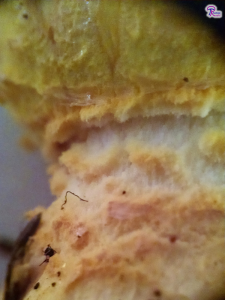
The Fly Agaric has concentric shaggy zones on its base that are created as the cap pulls away from the stipe and breaks the universal veil, as is happening in the picture above.
A. muscaria is present in a variety of art as well. Paintings, drawings, cartoons, and sculptures that include a mushroom usually opt for the colorful and recognizable Fly Agaric. Artworks depicting fairies or small animals sitting on/under/beside a mushroom almost always use A. muscaria. Lawn ornaments frequently feature small gnomes perched atop the Fly Agaric.4,6 The toadstool also gets an occasional cameo on the silver screen. In Fantasia, an A. muscaria fairy ring dances around to the tea dance from Tchaikovsky’s The Nutcracker. In many European countries, the Fly Agaric is a symbol of good luck and can be found alongside (or in place of) four-leaf clovers. A. muscaria is also a frequent addition to otherwise bland Christmas tree ornaments.4
Because of its over-use, artists occasionally get the mushroom’s ecology wrong. Most of the time, the Fly Agaric is correctly depicted growing from the ground. Sometimes, however, artists put the mushroom in the wrong environment. One example of this is the Pokémon games, where A. muscaria parasitizes an insect. I have also seen paintings depicting the toadstool decomposing logs. These instances always make me sad because there is such an amazing diversity of beautiful fungi that could be used without ignoring their proper habitat.
Amanita muscaria also had a profound impact on ancient cultures. Read FFF#121 to learn more about how the Fly Agaric influenced Vikings, Hinduism, Christianity, and others.
Taxonomy
Mycorrhizal partner preference is not the only characteristic that varies by region: cap color and size also differentiate a number of varieties or subspecies of A. muscaria. Mycologists denote these differences by adding “var. _____” or “subsp. _____” to the end of the scientific name. North America seems to host at least four varieties. The red variety (var. flavivolvata) is usually found in the Deep South and in the West. In the East, the most common cap color is yellow (var. percisina). An orange variety (var. guessowii) can be found in the Midwest and East.5,7 The white variety (var. alba) is less common but can be found throughout the continent.5,7,8
However, recent genetic evidence suggests that different cap colors do not necessarily indicate different genetic relationships. Amanita expert Rod Tulloss suggests that varieties of A. muscaria be defined based on the presence of two morphological differences (for example, cap color and mycorrhizal host). So far, this test has aligned reasonably well with DNA evidence, but that could change in the future as mycologists study the species further.1,5
| Kingdom | Fungi |
| Division (Phylum) | Basidiomycota |
| Subdivision (Subphylum) | Agaricomycotina |
| Class | Agaricomycetes |
| Subclass | Agaricomycetidae |
| Order | Agaricales |
| Family | Amanitaceae |
| Genus | Amanita |
| Species | Amanita muscaria (L.) Lam.9 |
This post does not contain enough information to positively identify any mushroom. When collecting for the table, always use a local field guide to identify your mushrooms down to species. If you need a quality, free field guide to North American mushrooms, I recommend Michael Kuo’s MushroomExpert.com. Remember: when in doubt, throw it out!
See Further:
http://www.mushroomexpert.com/amanita_muscaria_flavivolvata.html
http://botit.botany.wisc.edu/toms_fungi/dec99.html
http://www.botany.hawaii.edu/faculty/wong/BOT135/Lect18.pdf?q=amanita
http://www.botany.hawaii.edu/faculty/wong/BOT135/Lect20a.htm
Citations
- Kuo, M. Amanita muscaria var. flavivolvata. MushroomExpert.Com (2013). Available at: http://www.mushroomexpert.com/amanita_muscaria_flavivolvata.html. (Accessed: 22nd December 2017)
- Tulloss, R. E. Amanita muscaria. Studies in the Amanitaceae Available at: http://www.amanitaceae.org/?Amanita+muscaria. (Accessed: 22nd December 2017)
- Wood, M. & Stevens, F. California Fungi: Amanita muscaria. The Fungi of California Available at: http://www.mykoweb.com/CAF/species/Amanita_muscaria.html. (Accessed: 22nd December 2017)
- Volk, T. J. Tom Volk’s Fungus of the Month for December 1999. Tom Volk’s Fungi (1999). Available at: http://botit.botany.wisc.edu/toms_fungi/dec99.html. (Accessed: 22nd December 2017)
- Tulloss, R. E. Amanita muscaria subsp. flavivolvata. Studies in the Amanitaceae Available at: http://www.amanitaceae.org/?Amanita%20muscaria%20subsp.%20flavivolvata. (Accessed: 22nd December 2017)
- Wong, G. Lect18.pdf. Botany 135 Available at: http://www.botany.hawaii.edu/faculty/wong/BOT135/Lect18.pdf?q=amanita. (Accessed: 22nd December 2017)
- Kuo, M. The Genus Amanita. MushroomExpert.Com (2013). Available at: http://www.mushroomexpert.com/amanita.html. (Accessed: 22nd December 2017)
- Kuo, M. Amanita muscaria var. alba. MushroomExpert.Com (2013). Available at: http://www.mushroomexpert.com/amanita_muscaria_alba.html. (Accessed: 22nd December 2017)
- Amanita muscaria. Mycobank Available at: http://www.mycobank.org/Biolomics.aspx?Table=Mycobank&Rec=1133&Fields=All. (Accessed: 22nd December 2017)

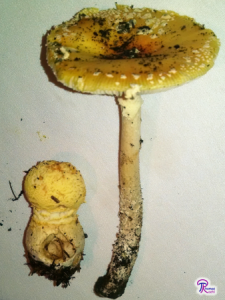
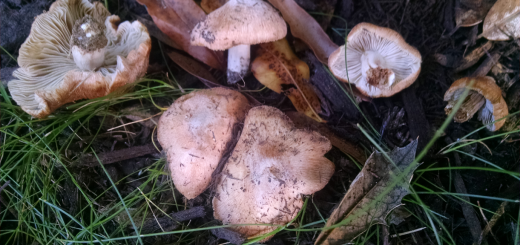
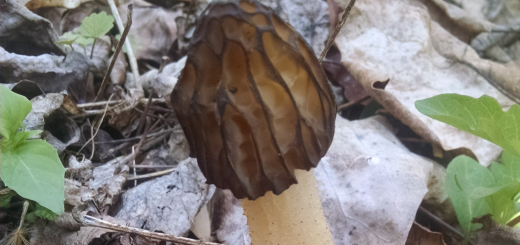






![#011: Characteristics of Kingdom Fungi [Archived]](https://www.fungusfactfriday.com/wp-content/themes/hueman/assets/front/img/thumb-small-empty.png)

